Entering the world of content creation can be overwhelming. Not only do you need to stand out from thousands of other creators who have the same goals of innovation, but you also need to find a sustainable content monetization strategy that keeps your audience coming back and growing.
In this guide, we’ll walk you through a series of scalable content monetization strategies that you can implement with your own content creation.
What is Content Monetization?
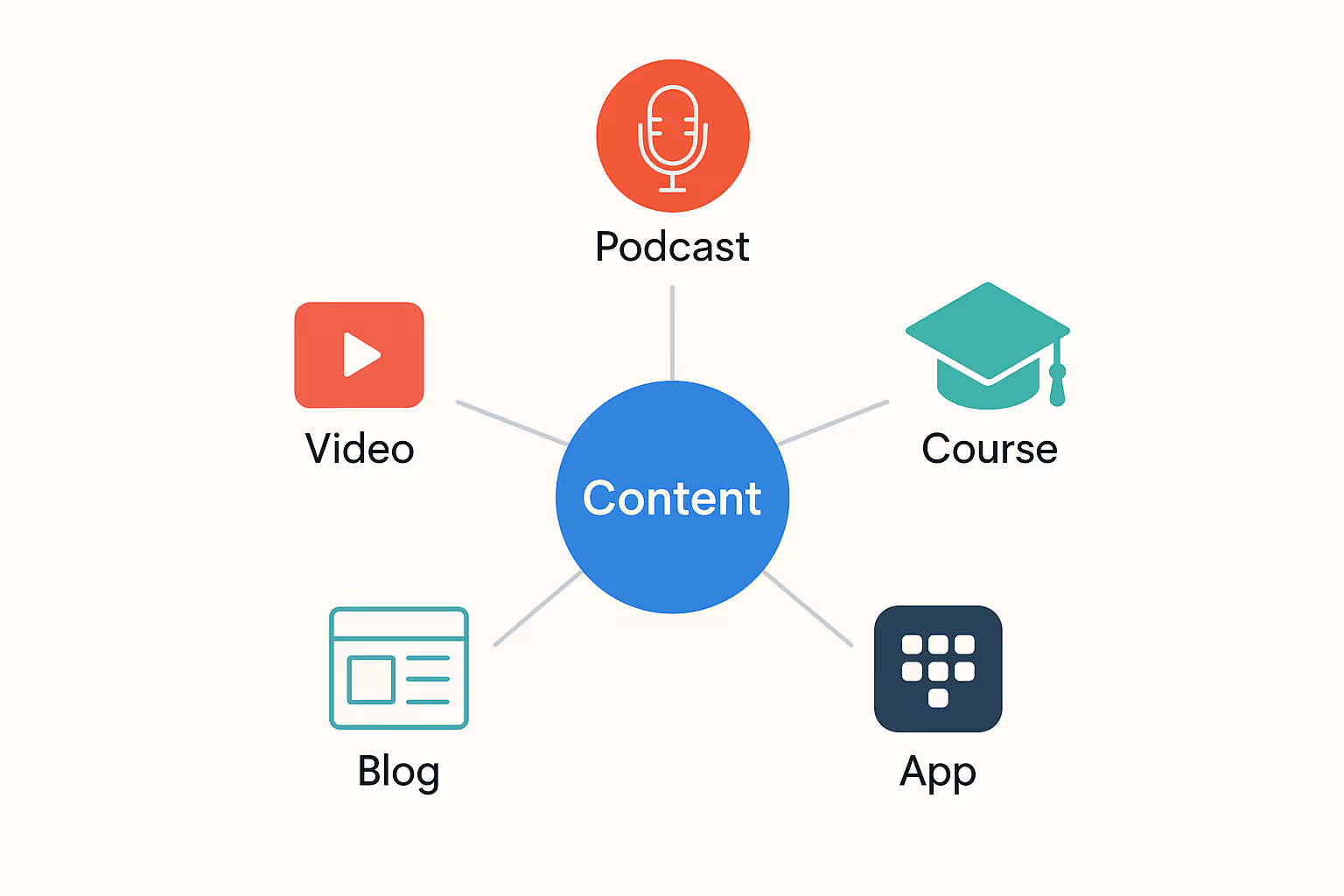
Content monetization specifically refers to the process of earning income by selling what you create. Content is an increasingly vague word. It can include (but is not limited to) things such as blogging, podcasting, digital products or services, and streaming audio or video.
Whether you’re an individual creator or an online business, the way you monetize your content can determine everything from the focus of your online content to your ability to grow as a brand.
Rise of the Content Creator Economy
According to recent estimates, there are over 207 million content creators worldwide, and this number is increasing daily. This can all be attributed to the continuing rise of the creator economy, a digital ecosystem of creators who produce and monetize their own content. It’s a system that’s worth over $250 billion and predicted to nearly double by 2027. And it’s a world that individuals and businesses are eager to enter, with such a low barrier to entry.
Three pillars of a content monetization strategy
Seeing the massive numbers for content creators, you may mistakenly believe that it’s an easy investment, but content creation’s success is entirely dependent on your choices and how they align with your audience’s needs. Principally, you need to decide three essential components for your content monetization strategy: content, distribution platform, and payment method.
Content
Content is the most self-explanatory element, but you shouldn’t underestimate that it needs to synchronize with your distribution and monetization plans perfectly. Most businesses (and many individual creators) rely on multi-faceted distribution methods, spreading out material across personal websites, emails, apps, or social media platforms.
Distribution Plan
Remember that a one-size-fits-all approach for any individual piece of content should never be an option, and each piece of content needs to be adapted to match the platform, audience, tone, and messaging requirements or expectations of those methods.
Brand visibility on social networks like Facebook, LinkedIn, YouTube, Instagram, and TikTok is an automatic requirement. Still, the success of your content strategy depends on an innate understanding of every choice you’re making as a content distributor.
Payment Method
The third and arguably most crucial component of monetization is deciding on the payment structure for your content. Possible strategies include everything from selective paywalls to sponsorships to crowdfunding to fund your continued content. Still, you need to be able to justify to your audience why they should pay for your content in the first place.
Role of trust and customer experience
Like any brand, the success of your content relies on a strong relationship between the customer and the brand. Your customer needs to find you trustworthy and authoritative as a source on whatever you’re selling.
Your main goal from the beginning should be to consistently show your readers and potential customers that you are both authentic and reliable, a needle that’s far more difficult to thread for corporate brands or traditional media outlets to replicate.
Polls from last year show that only 31% of people trust the media to report the news “fully, accurately, and fairly.” Content creators may not face the same burden of proof, but this number is instructive in showing that audiences will trust individuals before larger media bodies or unknown brands.
Likewise, successful content creators are able to cultivate a sense of authenticity and a personal connection with their audience, which can drive buying habits and influence public behavior. Your content must reflect this growing trust and consistently provide valuable insights for your audience.
Only through time and consistency will you find a loyal audience that can grow and carve out its own appropriate sustaining income method.
How to monetize your digital content?

Let’s get on to discussing the individual steps that you can take to help identify the right content monetization strategy.
Understanding your audience
Decisions about content monetization should begin with defining your target audience and understanding their needs and expectations from your content. It will involve asking internal questions about that target audience, whether they’re already engaging with you or you’re looking to reach them.
Examine the demographics of those individuals and search for patterns in their online interests and behaviors. Are they consistently looking at a single type of content that you’ve been putting out? Are there other markers that can help you understand your own audience?
By understanding your audience demographics, you’ll be able to tailor your content and maximize your engagement. And you’ll be much more efficient in crafting content and promoting products or services that you know your audience will appreciate.
This will vary based on your industry and the style of content you produce. However, it’s well worth your time as having concrete information about your audience will not only inform the type of content you create, but also help you determine how much you can charge your audience.
If you have a more affluent audience or offer content in a specialized space, you may be able to charge more than if you have a more general audience that may not have the same purchasing options.
Identifying your content monetization goals
Along with examining your audience and their characteristics, you should identify your financial goals with your content. Revenue is an immediately quantifiable figure that should be familiar to anyone in business. It’s a representation of the amount you’ve earned from your content. With a number in hand, your goals can focus solely on adjusting strategies that will lead to more revenue, such as implementing paywalls and memberships.
But for content creators, growth and influence are just as important as revenue generated from content. To increase growth, you could focus on attracting a larger audience, whether that involves creating new material or doubling down on the content that’s receiving the most engagement.
Or maybe you want to position your monetization strategy in terms of increasing your influence by cultivating partnerships with other creators who have audiences that you haven’t captured. Either of these scenarios is plausible, and each will dictate a different monetization approach. We’ll talk more about these use cases in the next section.
Evaluating where your audience is in their journey
You also want to map out your audience’s journey in terms of their interactions with you as a business and customer. A variation of the Customer Lifecycle that businesses use to understand how a customer progresses from initial awareness of a product to purchasing it. The audience journey is a visualization of the stages through which a person who has never heard of you could ultimately become a promoter of your content.
Here are the stages of the Audience Journey:
- Unaware: Audience that has no knowledge of you or your content.
- Aware: Person has seen your content or heard about you.
- Engaged: Engagement through following accounts or clicking through to a website through your content.
- Subscribed: The segment of your audience who trust you and find your content valuable enough to pay for it.
- Committed: Subscribers, who are becoming more involved with content through chosen gestures.
- Active Users: Regular readers or users.
- Promoters: Telling others about you.
By following this framework, you’ll be able to understand where you fit into your audience’s life and how much they’ve bought into your content. If you’re still trying to make them aware of your existence, subscriptions aren’t going to get anyone in the door. However, if you have regular engagement with your content, you can consider other content monetization strategies, such as crowdfunding or other forms of patronage.
Core Content Monetization Strategies
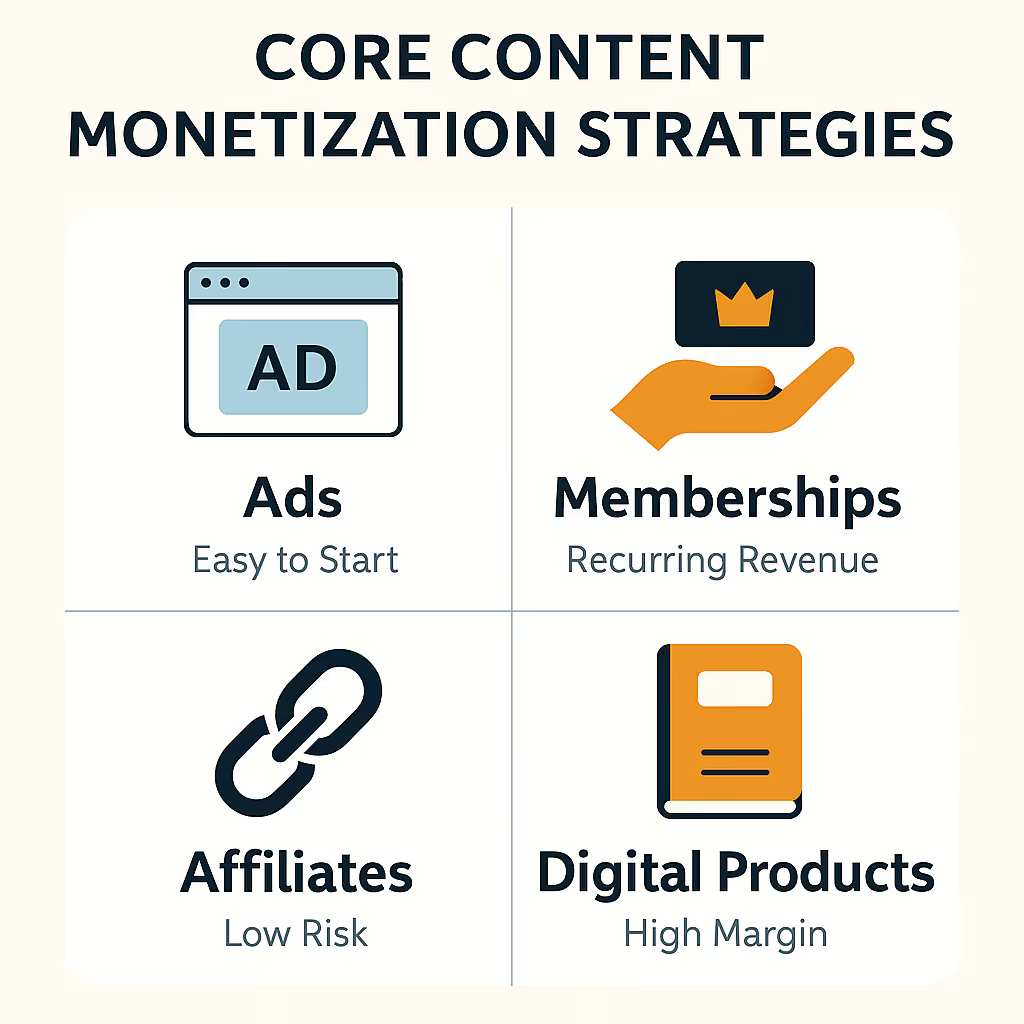
Now, let’s discuss in detail some of the core content monetization strategies that you can implement, the advantages and disadvantages of each, and best practices for these individual methods.
Advertising
Digital advertising is one of the most traditional monetization models. It includes display ads, native ads, banner ads, sponsored content, as well as PPC ads on Google and social networks like Facebook and LinkedIn. Let’s break down each of these kinds of ads:
Types of Advertising
- Display Ads: Appear in content or through pop-ups when users scroll through a page.
- Native Ads: Designed to blend seamlessly with the web page's style.
- Banner Ads: Appear prominently on the header, footer, or sidebar.
- Sponsored Content: Paid or promotional material for an advertiser that is circulated by another brand, publisher, or individual.
- PPC Ads: Pay-per-click ads that are on search engine results pages, social media
Advantages of an advertising-focused content monetization strategy
- Passive income based on views.
- Audience is accustomed to ads.
- You have complete control over messaging.
Disadvantages of Advertising-Based Monetization
- Depending on their location, they can be distracting in your content.
- A minimal amount of money, unless you’re a big brand.
Best Practices
- Be transparent about your need for ads.
- Make access as easy as possible.
- Try to make advertising as organic as possible within the content to maintain a seamless user experience.
Subscriptions and Memberships
With a subscription or membership-based content monetization model, your audience will pay a recurring fee to access your content over a specified period. For businesses selling a product or service, this can also involve offering tiered options with varying levels of complementary access to the product.
They could be sold in tiers, such as free, premium, and founder, each offering its own appeal based on how much your audience wants to engage with you. The free tier may provide a limited number of articles that you can access without a paywall.
While a premium tier would allow for unlimited access to your content. A founder tier would offer unlimited access, along with exclusive content, whether that be additional content, all past content or earlier access to existing content.
Advantages of a content monetization strategy revolving around subscriptions and memberships:
- Predictable revenue
- Customer loyalty
- Scalability
Disadvantages of Subscriptions and Memberships include:
- Requires continuous content creation to retain customers
Best Practices
- Engage with your subscribers. Customer delight can convert subscribers into your brand advocates.
- Create an optimized subscription page.
Affiliate Marketing
Affiliate marketing is a monetization strategy where you pay partners a commission for driving sales or new leads to your business.
Advantages of an affiliate-centric content marketing strategy:
- Pay only for results. Less marketing risk and guaranteed conversions if it succeeds.
- You have a built-in audience as your chosen affiliates already have an audience who trusts them. Just ensure that the affiliate aligns with your brand.
- It is scalable. You can reach out to affiliates of different sizes.
Disadvantages of Affiliate Marketing include:
- Revenue is dependent on the affiliate’s success.
- Higher risk of unethical practices.
- Your earnings depend on the commission cost that the affiliate retains.
Best Practices
- Choose an affiliate that aligns with your own content and brand values.
- Disclose all links that are affiliate links.
- Find trustworthy and ethical affiliates that maintain high standards, as your reputation gets tied to theirs.
Digital Products and Services
Digital products and services are external pieces of content that followers must pay for to access. They can be things like templates, guides, e-books, consulting, and educational courses that inform and capture your audience’s attention.
Advantages of making sponsored content the core of your content marketing strategy:
- You potentially already have the raw materials to create these.
- Low overhead and maximum profits.
- Lower barrier to entry.
Disadvantages of Monetizing with Digital Products and Services:
- Upfront time and effort to create.
- More competition (including with free alternatives).
- You may have to provide ongoing support and updates.
Best Practices
- Create products that solve clear, specific problems your audience already cares about.
- Validate demand before you build. Use surveys, waitlists, or pre-sales to confirm interest.
- Focus on high perceived value. Design your digital products (courses, templates, guides) to appear polished and professional, justifying the price.
- Bundle and upsell smartly. Offer packages or complementary add-ons to increase average order value.
Sponsored Content and Partnerships
Sponsored content and partnerships involve working directly with brands or businesses that pay you to feature their products, services, or messaging within your content. This could take the form of articles, videos, social media posts, newsletters, or podcasts that integrate the sponsor’s message in a way that feels natural and relevant to your audience.
Unlike generic ads or affiliate links, sponsored content enables custom, branded storytelling, allowing you to have more control over how the message is presented. Partnerships can also go beyond one-off posts, leading to long-term collaborations, co-branded products, or joint campaigns that generate significant revenue. When done thoughtfully, sponsored content monetizes your platform while delivering value to both your audience and the sponsor.
Advantages and disadvantages
- Builds substantial revenue through direct brand deals, often higher than ad networks.
- Strengthens relationships with brands that can lead to long-term partnerships.
- It can align well with your content theme, adding value for both the audience and the sponsor.
- It’s flexible, allowing you to create unique, branded experiences (articles, videos, tools).
- Enhances your authority if you partner with respected brands in your niche.
Disadvantages of Sponsored Content and Partnerships:
- Risk of alienating your audience if sponsorships feel intrusive or irrelevant.
- Requires time to pitch, negotiate, and manage partnerships.
- May compromise creative control if sponsors dictate too many terms.
- Income can be inconsistent, especially in the early stages.
Best Practices
- Prioritize sponsors that align with your audience’s interests and values.
- Clearly label sponsored content to maintain transparency and trust.
- Balance sponsored content with regular, unsponsored posts to avoid oversaturation.
- Set clear deliverables and expectations in contracts to protect your creative integrity.
- Utilize metrics (such as engagement and conversions) to demonstrate value and secure future deals.
Advanced Content Monetization Strategies
We’ve discussed the more traditional monetization methods, but other, more advanced options can maximize your profit potential and change the way you think about monetizing your content.
Micropayments
Micropayments are a content monetization strategy where users pay small amounts to access individual pieces of content, such as articles, videos, or tools. Instead of committing to a subscription, visitors can choose to pay only for what they find valuable.
This model works because it lowers the barrier to entry for casual users who might hesitate to subscribe but are willing to make occasional, low-cost purchases. It’s especially effective for sites with high traffic or diverse content, as it captures revenue from audiences that would otherwise leave without converting. When implemented effectively, micropayments strike a balance between accessibility and monetization.
However, success with microtransactions depends on selecting the right content monetization platform for implementing them. The platform must offer seamless integration, low transaction fees, and a smooth user experience to avoid deterring small purchases. The right solution ensures reliable tracking, flexible payment options, and scalability as your audience grows, helping maximize revenue without friction.
With tools like Supertab, you can immediately convert access to gated content into revenue through low-friction micropayments. Through integration options with your platform, you can offer aggregated payments for premium content, time-based features, or digital goods, all with minimal effort.
Combination Models
Combination models are precisely what their name suggests. This monetization strategy involves using multiple monetization methods simultaneously. For instance, you may be relying on a combination of native ads, memberships, digital products, and affiliate links simultaneously.
Some approaches naturally complement each other. For example, offering free content supported by ads while upselling premium guides or templates works well. Combining models can help balance steady income with high-value purchases.
As long as you’re careful about not undermining the value of your content by employing too many types of monetization, it’s a smart way to maximize your potential profit and offer the most value to the largest group of people.
Licensing and Syndication
Licensing and Syndication are two types of content creation monetization techniques that are about granting permission to others to use or distribute your work. Ideally, that will allow you to reach new markets and audiences.
Content licensing is a process of granting legal permission for others to use, reproduce, or distribute copyrighted material, usually in exchange for a fee or royalty payment. Syndication is related, but it involves distributing content to multiple platforms simultaneously to expand the content’s reach.
If you prefer to deal with one third-party source, you can also provide sole permission to one source or a selection of sources.
Crowdfunding and Patronage Services
Sometimes overlapping with subscription monetization models, crowdfunding and patronage services are two monetization strategies that invite fans of your content to contribute directly to you.
This can be achieved through crowdfunding platforms like Kickstarter, where you can offer exclusive perks to those who contribute a certain amount to a project, or through platforms like Ko-Fi and Tipeee, where individuals can make individual donations to content creators.
Social Tokens
Social Tokens are a form of content monetization that allows individuals to use cryptocurrency to support content creators. While traditional monetization methods rely on third-party platforms, social tokens give content creators more control by bypassing traditional systems.
By monetizing through social tokens, you can establish a more personal connection with your supporters. Through social tokens, content creators can offer exclusive content, experiences, or other incentives that give fans a greater sense of ownership in the content they’re engaging with.
When implementing social tokens as a content monetization strategy, there are several important factors to keep in mind:
- Audience education: Many users may be unfamiliar with how social tokens work. You’ll need to clearly explain what they are, how to use them, and what value they provide to avoid confusion or hesitation.
- Regulatory compliance: Because social tokens often intersect with cryptocurrency and digital assets, it’s crucial to stay on top of legal and tax implications in your region to avoid unintentional violations.
- Volatility and trust: Token values can fluctuate, so it’s essential to establish fair pricing for content access or perks and manage expectations regarding value stability.
- User experience: The process of acquiring and using tokens should be as seamless as possible. Complicated setups or tech barriers can deter potential supporters.
- Long-term sustainability: Social tokens should add meaningful value, not feel gimmicky. Focus on creating genuine community engagement and exclusive benefits that make holding or spending tokens worthwhile.
Technical and operational considerations behind the deployment of your chosen content marketing strategies
You have the content monetization strategy, but the technical and operational considerations also play a key role, as they’ll dictate your users’ experience as they navigate through your chosen monetization methods.
Choosing platforms and tools for monetization
Selecting the right platforms and tools is a crucial aspect of developing content monetization strategies that can scale effectively. The tools you choose should align with your content type, audience preferences, and long-term business goals.
For example, a site offering premium articles might prioritize paywalls or subscription platforms, while one focused on digital products could benefit from e-commerce integrations and secure file delivery systems. Look for solutions that offer flexibility, reliable analytics, and easy integration with your existing setup. It’s also important to consider transaction fees, payment processing options, and how well the platform handles taxes and compliance.
A poor platform choice can create friction for users, slow growth, or lead to missed revenue opportunities. Investing time upfront to evaluate the best-fit tools ensures your monetization efforts are both user-friendly and operationally efficient as you scale. The proper foundation helps you adapt your strategy over time without unnecessary headaches.
Importance of analytics and conversion tracking
Choosing a content monetization strategy is not the end of the process of growing as a brand. In fact, not only do you need to release quality content consistently, but you also need to evaluate its performance. There are many tools and integrations available that can help you monitor these metrics, but there are particular metrics that are more useful to you than others.
You want to continually experiment and closely monitor your analytics to ensure that you’re receiving the desired results from your content. Then, you can optimize your monetization strategies based on the trends you’re seeing. By monitoring those metrics, you’ll be able to make informed decisions that will maximize the performance of your content.
Along with general analytics, you also want to monitor your conversion tracking, or the number of people who ultimately spend money to access your content. Metrics like click-through rates and conversion rates are far more valued by potential collaborators than likes or shares.
The role of A/B testing in optimization
Another essential form of experimentation is conducting A/B testing. Essentially, A/B testing refers to the release of two versions of a webpage or email to different segments of users. This way, you’ll be able to make decisions based on real data instead of just guessing to see what people prefer.
In the case of content creation, you can change one thing, such as text length, writing style, punctuation, tone, headline, language of the CTA, or adding image assets. It could be as simple as having two versions of content, where half of your visitors see the original headline and the other half see the new one.
Once you release these two versions, track the results based on key metrics such as conversions, likes, reach, shares, and sign-ups. If there doesn’t seem to be a significant variation in results, then the variable you tested was inconclusive, and you should default to the original option. But if one version yielded distinct results, then disable the losing variation.
By optimizing these elements, you can increase user engagement, boost conversion rates, decrease bounce rates, and gain a deeper understanding of your target audience's preferences.
Avoiding common mistakes
Let’s address the most common mistakes that content creators run into with their online content monetization strategies.
Mistake #1: Failing to Educate Readers About Subscriptions
There’s no proven science on how you can structure subscriptions for potential customers. One of the biggest issues can be the content creator's inability to justify why a subscription is worth the money. If you’re offering a subscription, it needs to be immediately clear to your audience why they should spend money to gain access and why their support matters.
The most successful subscription strategies show potential customers exactly what they will receive with their subscription, whether it’s exclusive content, an ad-free experience, or the opportunity to support your content.
Like any form of advertising, there’s a thin line between being too pushy and enticing someone to buy a subscription. The most important thing, though, is to be transparent about how their support materially helps you and the personal value you can offer.
Mistake #2: Choosing A Misaligned Revenue Model
As discussed earlier, all audiences will not respond to the same monetization models. When monetizing your content, ensure that you understand why your audience likes your content and the type of content that they like most.
Subscriptions may sound like an easy way to generate revenue, but if you misunderstand the commitment your readers feel toward you, you will push them away before they have the chance to get to know you.
Alternatively, a fully bought-in audience may balk if you add too many advertisements or disruptive monetization methods to a site experience that they appreciated for being less disruptive than other options. Always think about what your audience expects and wants from you before making monetization decisions.
Mistake #3: Forgetting About Email Marketing
As you find a groove with content creation, you may find yourself leaning toward certain platforms, but don’t forget about email marketing in the process. Email marketing sounds benign, but know that it has one of the highest ROIs for marketers.
Through general and personalized emails, you can build a relationship with your audience and encourage them to explore recent, exclusive content offers and relevant updates.
It’s also an easy conduit to convert leads more quickly than other methods. Just make sure to include an easily accessible link to a Call-to-action (CTA) landing page so that your readers can access your paid options with a single click.
Take the Next Step Toward Smarter Content Monetization
Finding the right content monetization strategy won’t be an easy process, but through in-depth research of your audience and their preferences, thoughtful experimentation, and consistently strong content, you’ll be on the right path.
It may require more than one of these strategies. Still, through savvy hybridizations of methods like affiliate links, selling digital products, and leveraging micropayments, you’ll secure a future for yourself or your business as a source of content creation.
And when you’re ready to take the next step toward smarter content monetization, Supertab can empower you to streamline your strategy through seamless, frictionless microtransactions.
Whether you’re a content creator or an established business, this new monetization model can help you capture the attention of those visitors who were always one click away from being loyal customers. Explore Supertab Experiences now.

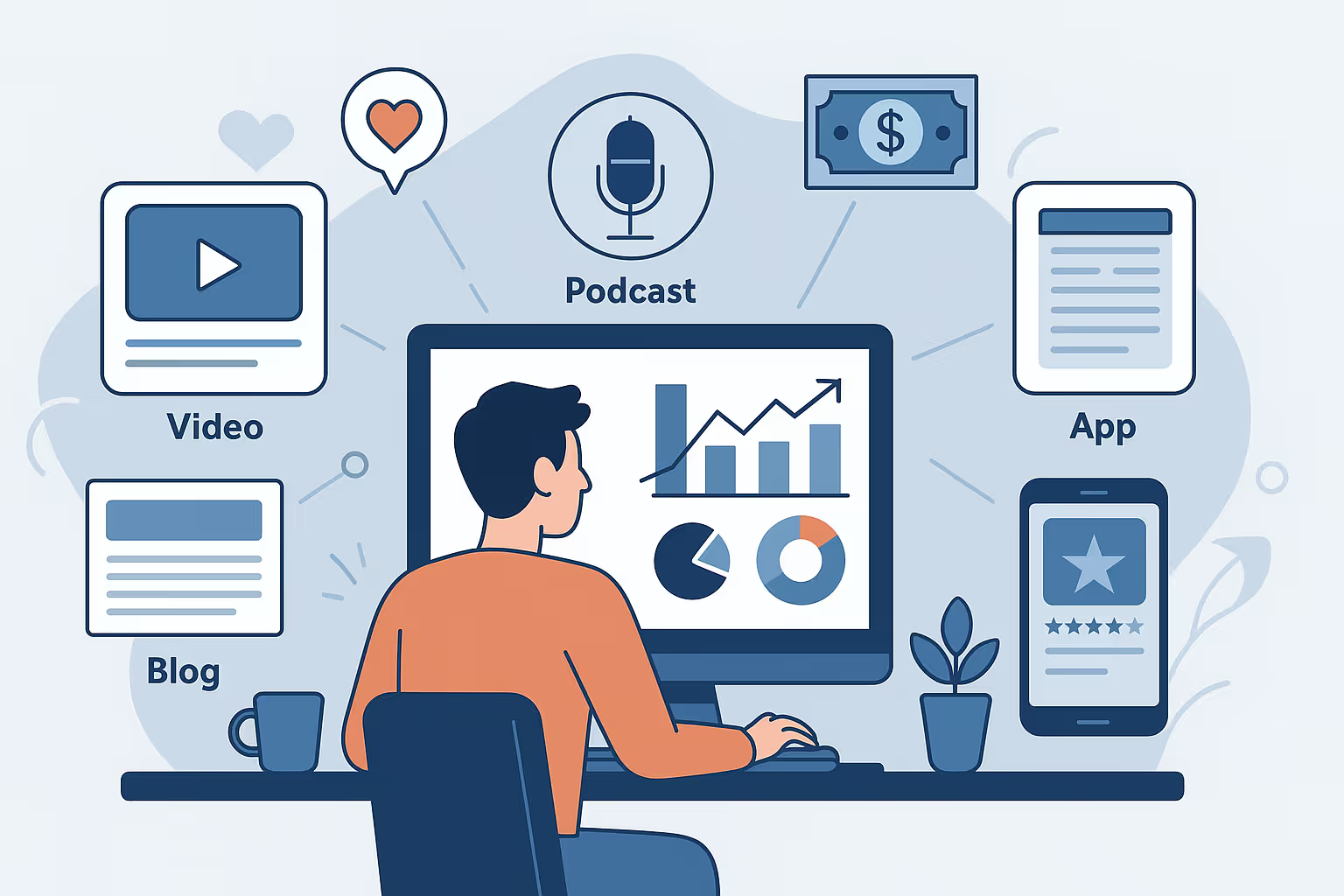
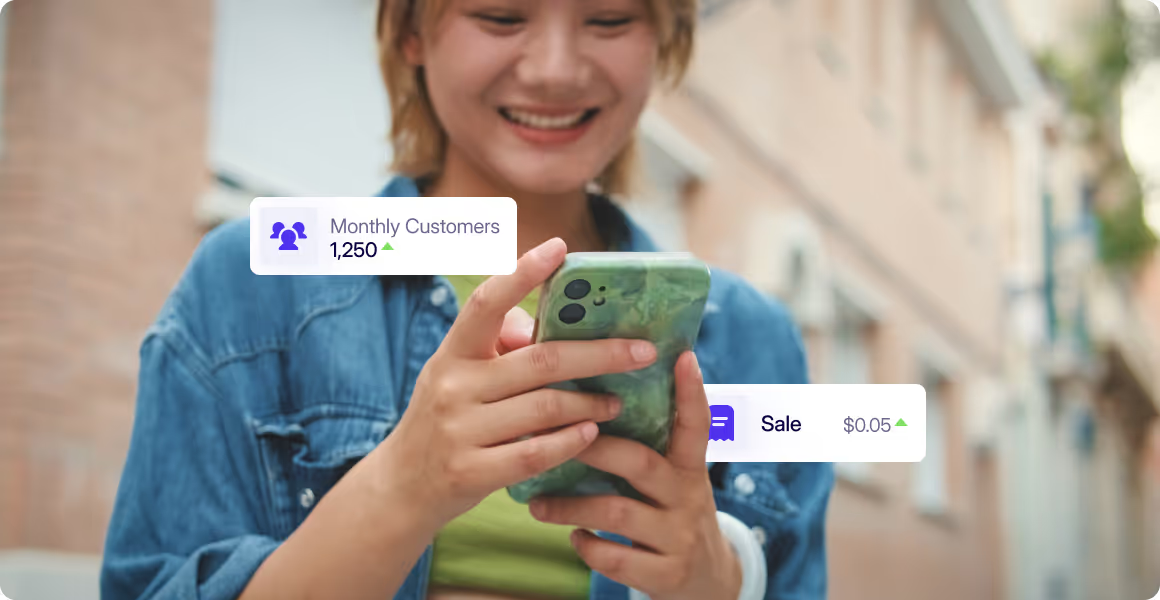
.svg)
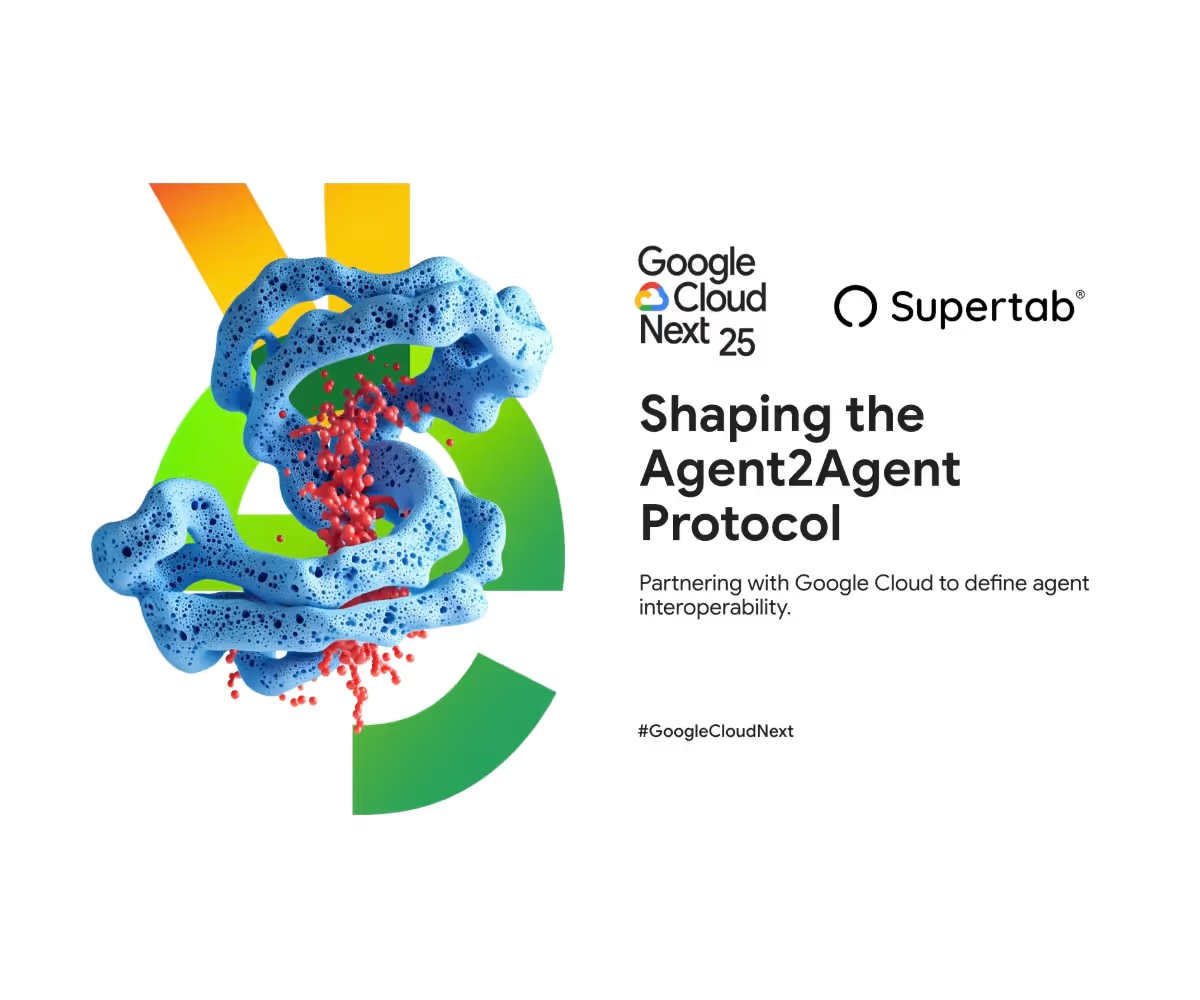
.avif)


